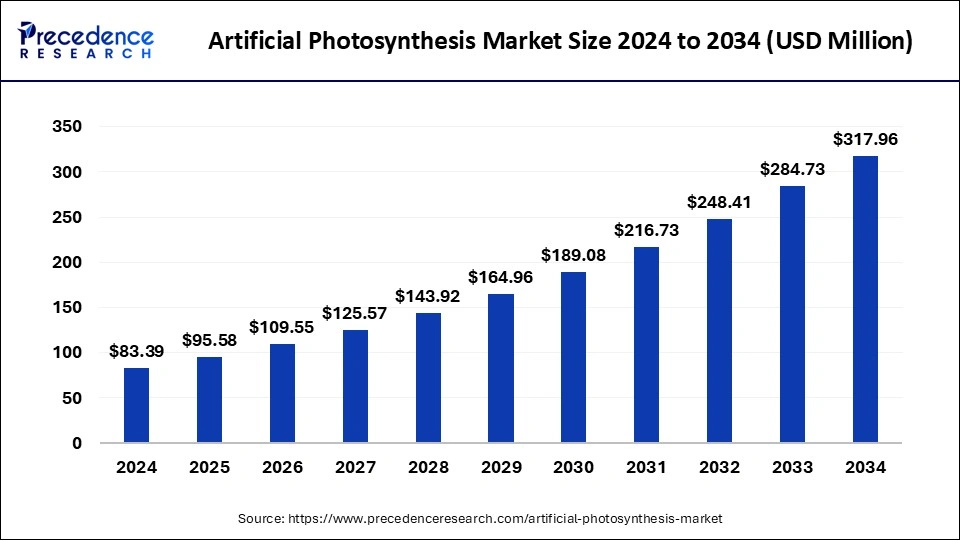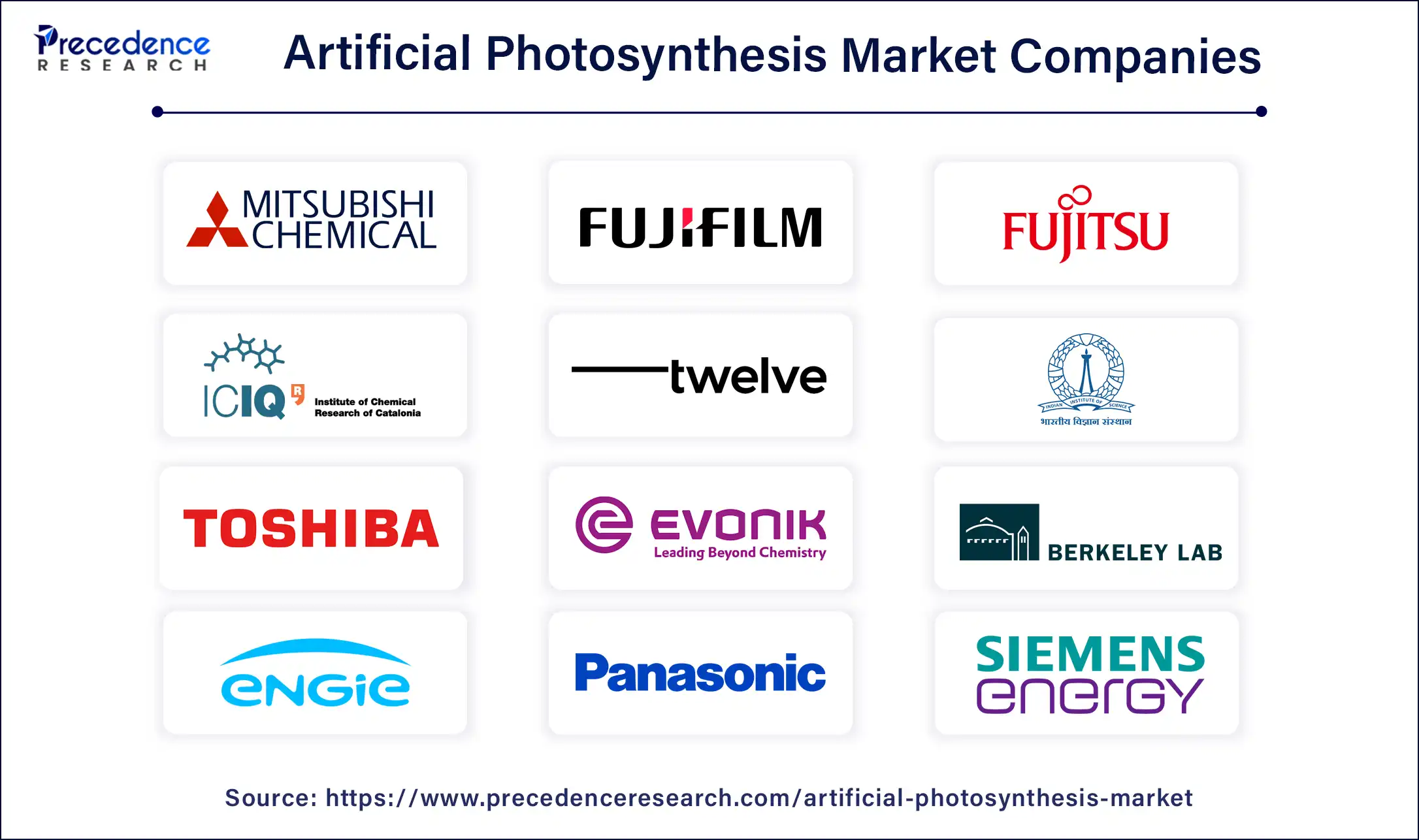The global artificial photosynthesis market size is calculated at USD 95.58 million in 2025 and is forecasted to reach around USD 317.96 million by 2034, accelerating at a CAGR of 14.32% from 2025 to 2034. The market sizing and forecasts are revenue-based (USD Million/Billion), with 2024 as the base year.
The global artificial photosynthesis market size was estimated at USD 83.39 million in 2024 and is predicted to increase from USD 95.58 million in 2025 to approximately USD 317.96 million by 2034, expanding at a CAGR of 14.32% from 2025 to 2034. An increase in awareness about the environment and the benefits of clean energy is estimated to fuel the growth of the market over the forecast period.

The artificial photosynthesis market is growing due to the adoption of green technologies and the reduction of greenhouse gases. Artificial photosynthesis is a biological reaction projected after the well-known natural process of photosynthesis. An enzyme bed reactor (or any other source requiring carbon dioxide to be extracted) is part of the artificial photosynthesis system. Bioelectric transducers and hydrogen energy are the sources of energy for this reactor. The main elements of a complete artificial photosynthesis system are:
The integration of electrocatalysis with photocatalysis through the photoelectrochemical strategy is a captivating method for solar-to-chemical energy conversion known as artificial photosynthesis. Metal-organic frameworks can significantly advance this crucial area of study because of their structural regularity and synthetic tunability. The use of metal-organic frameworks to achieve artificial photosynthesis through the photoelectrochemical pathway has advanced recently, as this brief summary illustrates. Artificial photosynthesis is acknowledged as one method of obtaining energy from solar radiation.
| Report Coverage | Details |
| Market Size by 2034 | USD 317.96 Million |
| Market Size in 2025 | USD 95.58 Million |
| Growth Rate from 2025 to 2034 | CAGR of 14.32% |
| Largest Market | North America |
| Base Year | 2024 |
| Forecast Period | 2025 to 2034 |
| Regions Covered | North America, Europe, Asia-Pacific, Latin America, and Middle East & Africa |
Increase in the use of artificial photosynthesis for energy regeneration
Increasing innovations for developing renewable energy sources by use of artificial photosynthesis are estimated to fuel the growth of the artificial photosynthesis market over the forecast period. For instance, in June 2024, Optical-Bio Microsystems Lab, a biomedical lab, unveiled the algae that holds the capacity to generate renewable electricity. The approach utilized by Optical-Bio Microsystems Lab to collect energy from the photosynthesis of algae housed in miniature power cells and suspended in a specific solution was described. When set up properly, these cells have the capacity to produce enough energy to run ultra-low- and low-power devices, like Internet of Things (IoT) sensors.
Challenges in catalyst optimization and rise in the need for photoanode material stability
The need for stability of photoanode material and the requirement for an optimum catalyst is expected to hamper the growth of the artificial photosynthesis market over the forecast period. For instance, in January 2024, Nikalyte Ltd, a nanotechnology engineering service company, estimated that the use of nanoparticle materials in artificial photosynthesis has several difficulties. This is not surprising, though, as it can occasionally be challenging, if not impossible, to intentionally replicate any natural process. The most effective catalysts and light-harvesting devices to use are among the challenges associated with artificial photosynthesis. Reducing carbon monoxide production and improving conversion efficiency to high-order hydrocarbons provide further difficulties.
Rise in research and development activities for innovating new products
An increase in the research and development activity for designing new products using artificial photosynthesis has created a lucrative opportunity for the growth of the artificial photosynthesis market during the forecast period. For instance, in February 2024, the Institute of Metal Research Chinese Academy of Sciences, a research institute focused on developing new types of inorganic non-metallic materials, advanced composite materials, and high-performance metallic materials, announced that they had innovated a liquid metal-embraced photoactive film and artificial leaf. The artificial leaves were manufactured through direct water splitting, which uses solar energy to make hydrogen, opening the door for large-scale manufacturing. The newly developed liquid metal-embraced photoactive film has enormous potential for direct sun-to-hydrogen energy conversion since it works similarly to a natural leaf in converting solar energy directly into a chemical fuel.
The co-electrolysis segment held the dominating share of the artificial photosynthesis market in 2024. Reducing carbon dioxide emissions has become essential in the quest for a sustainable future as our society deals with the urgent issues of climate change and global warming, which are partially caused by rising atmospheric carbon dioxide levels. Conventional chemical industrial procedures frequently depend on fossil fuels, which unavoidably release significant amounts of carbon dioxide. As a result, when driven by renewable energy sources, electrochemical processes have attracted attention due to their potential to be more ecologically friendly and show a lesser carbon footprint. Increasing research and development activities using co-electrolysis technology to innovate renewable energy sources and food is estimated to drive the growth of the segment over the forecast period.
North America dominated the artificial photosynthesis market with the largest share in 2024. The rise in demand for renewable fuel and storage energy, as well as the rise in research and development activity in the North American region, is expected to drive the growth of the artificial photosynthesis market in the North American region. A robust high-tech industry with expertise in nanotechnology, materials science, and chemical engineering, essential for developing efficient artificial photosynthesis systems. Availability of substantial grants and funding programs aimed at promoting renewable energy technologies promotes the growth of the market.
Furthermore, in January 2024, according to the data published by the Sustainable Energy in America 2024 Factbook, a non-profit organization, it was estimated that in the US, energy transition financing of US$303.3 billion was used for investments in renewable energy, electric cars, power infrastructure expansion, and other clean energy technology.
Asia Pacific is expected to witness the fastest growth over the forecast period owing to increasing research and development activity for the development of the new artificial photosynthetic system. A highly skilled workforce with expertise in relevant fields such as chemistry, biology, and engineering acts as a growth factor for the artificial photosynthesis market. A vibrant startup ecosystem that fosters innovation and the development of new technologies.

By Technology
By Geography
For inquiries regarding discounts, bulk purchases, or customization requests, please contact us at sales@precedenceresearch.com
No cookie-cutter, only authentic analysis – take the 1st step to become a Precedence Research client